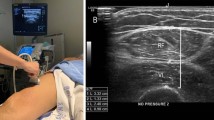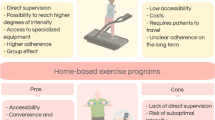Abstract
Background
Physical exercise could improve functional limitations, muscle mass, and health-related quality of life (HRQoL) in patients with cirrhosis.
Aim
The purpose of this study was to evaluate the efficacy and safety of an exercise programme and leucine supplementation to increase exercise capacity, muscle mass, and HRQoL in patients with cirrhosis.
Patients and Methods
Seventeen outpatients with cirrhosis were randomized to an exercise group (n = 8) or a control group (n = 9) in a pilot study. The programme of moderate exercise was performed for 12 weeks under supervision of a physiotherapist. All patients received oral leucine (10 g/day) during the study. At baseline and at the end of the study, we determined exercise capacity (6-min walk and 2-min step tests), anthropometric measurements, and HRQoL by Short Form-36 (SF-36) questionnaire. We also analyzed safety regarding complications of cirrhosis, liver and renal function, inflammatory response and oxidative stress.
Results
In the exercise group, exercise capacity improved, as shown by the increase in the 6-min walk test from 365 (160–420) to 445 m (250–500) (p = 0.01), and in the 2-min step test (p = 0.02). Lower thigh circumference also increased, from 41 (34–53) to 46 cm (36–56) (p = 0.02), and the domains of SF-36 general health (p = 0.03), vitality (p = 0.01) and social function (p = 0.04) improved significantly. In the control group, no statistically significant changes were observed in any of the parameters. We did not observe complications of cirrhosis in either group during the study.
Conclusions
A programme of moderate physical exercise together with leucine supplements in patients with cirrhosis is safe and improves exercise capacity, leg muscle mass and HRQoL.


Similar content being viewed by others
References
Alberino F, Gatta A, Amodio P, et al. Nutrition and survival in patients with liver cirrhosis. Nutrition. 2001;17:445–450.
Montano-Loza AJ, Meza-Junco J, Prado CM, et al. Muscle wasting is associated with mortality in patients with cirrhosis. Clin Gastroenterol Hepatol. 2012;10:166–173.
Jones JC, Coombes JS, Macdonald GA. Exercise capacity and muscle strength in patients with cirrhosis. Liver Transpl. 2012;18:146–151.
Kachaamy T, Bajaj JS, Heuman DM. Muscle and mortality in cirrhosis. Clin Gastroenterol Hepatol. 2012;10:100–102.
Terziyski K, Andonov V, Marinov B, Kostaniev S. Exercise performance and ventilatory efficiency in patients with mild and moderate liver cirrhosis. Clin Exp Pharmacol Physiol. 2008;35:135–140.
Alameri HF, Sanai FM, Al Dukhayil M, et al. Six minute walk test to assess functional capacity in chronic liver disease patients. World J Gastroenterol. 2007;13:3996–4001.
Román E, Córdoba J, Torrens M, et al. Falls and cognitive dysfunction impair health-related quality of life in patients with cirrhosis. Eur J Gastroenterol Hepatol. 2013;25:77–84.
Carey EJ, Steidley DE, Aqel BA, et al. Six-minute walk distance predicts mortality in liver transplant candidates. Liver Transpl. 2010;16:1373–1378.
Córdoba J, Mínguez B. Hepatic encephalopathy. Semin Liver Dis. 2008;28:70–80.
Olde Damink SW, Jalan R, Redhead DN, et al. Interorgan ammonia and amino acid metabolism in metabolically stable patients with cirrhosis and TIPSS. Hepatology. 2002;36:1163–1171.
Hunter GR, McCarthy JP, Bamman MM. Effects of resistance training in older adults. Sports Med. 2004;34:329–348.
Tabet JY, Meurin P, Driss AB, et al. Benefits of exercise training in chronic hearth failure. Arch Cardiovasc Dis. 2009;102:721–730.
Segura-Orti E, Johansen KL. Exercise in end-stage renal disease. Semin Dial. 2010;23:422–430.
Dereli EE, Yaliman A. Comparison of the effects of a physiotherapist-supervised exercise programme and a self-supervised exercise programme in quality of life in patients with Parkinson’s disease. Clin Rehabil. 2010;24:352–362.
Duarte-Rojo A, Torres-Vega MA, Villamil-Ramírez H, et al. Changes in peripheral blood mononuclear cells glutamine synthetase mRNA after exercise in healthy volunteers: exploring an alternative proposal for non hepatic ammonia metabolism. Rev Invest Clin. 2012;64:164–172.
Ploeger HE, Takken T, de Greef MH, Timmons BW. The effects of acute and chronic exercise on inflammatory markers in children and adults with a chronic inflammatory disease: a systematic review. Exerc Immunol Rev. 2009;15:6–41.
Guarner C, Soriano G. Bacterial translocation and its consequences in patients with cirrhosis. Eur J Gastroenterol Hepatol. 2005;17:27–31.
García-Pagán JC, Santos C, Barberá JA, et al. Physical exercise increases portal pressure in patients with cirrhosis and portal hypertension. Gastroenterology. 1996;111:1300–1306.
Bandi JC, García-Pagán JC, Escorsell A, et al. Effects of propranolol on the hepatic hemodynamic response to physical exercise in patients with cirrhosis. Hepatology. 1998;28:677–682.
Saló J, Guevara M, Fernández-Esparrach G, et al. Impairment of renal function during moderate physical exercise in cirrhotic patients with ascites: relationship with the activity of neurohormonal systems. Hepatology. 1997;25:1338–1342.
Sinniah D, Fulton TT, McCullough H. The effect of exercise on the venous blood ammonium concentration in man. J Clin Pathol. 1970;23:715–719.
Mergener M, Martins MR, Antunes MV, et al. Oxidative stress and DNA damage in older adults that do exercise regularly. Clin Biochem. 2009;42:1648–1653.
Jalan R, Kapoor D. Reversal of diuretic-induced hepatic encephalopathy with infusion of albumin but not colloid. Clin Sci. 2004;106:467–474.
Lee KC, Yang YY, Wang YW, et al. Increased plasma malondialdehyde in patients with viral cirrhosis and its relationship to plasma nitric oxide, endotoxin and portal pressure. Dig Dis Sci. 2010;55:2077–2085.
Ritland S, Petlund CF, Knudsen T, Skrede S. Improvement of physical capacity after long-term training in patients with chronic active hepatitis. Scand J Gastroenterol. 1983;18:1083–1087.
Campillo B, Fouet P, Bonnet JC, Atlan G. Submaximal oxygen consumption in liver cirrhosis. Evidence of severe functional aerobic impairment. J Hepatol. 1990;10:163–167.
Pattullo V, Duarte-Rojo A, Soliman W, et al. A 24-week dietary and physical activity lifestyle intervention reduces hepatic insulin resistance in the obese with chronic hepatitis C. Liver Int. 2013;33:410–419.
Konishi I, Hiasa Y, Tokumoto Y, et al. Aerobic exercise improves insulin resistance and decreases body fat and serum levels of leptin in patients with hepatitis C virus. Hepatol Res. 2011;41:928–935.
Kawaguchi T, Izumi N, Charlton MR, Sata M. Branched-chain amino acids as pharmacological nutrients in chronic liver disease. Hepatology. 2011;54:1063–1070.
Les I, Doval E, García-Martínez R, et al. Effects of branched chain amino acids supplementation in patients with cirrhosis and a previous episode of hepatic encephalopathy. Am J Gastroenterol. 2011;106:1081–1088.
Walker DK, Dickinson JM, Timmerman KL, et al. Exercise, amino acids and aging in the control of human muscle protein synthesis. Med Sci Sports Exerc. 2011;43:2249–2258.
ATS Committee on Proficiency Standards for Clinical Pulmonary. Function laboratories. ATS statement: guideline for the six-minute walk test. Am J Respir Crit Care Med. 2002;166:111–117.
Weissenborn K, Ennen JC, Schomerus H, Rückert N, Hecker H. Neuropsychological characterization of hepatic encephalopathy. J Hepatol. 2001;34:768–773.
Romero-Gómez M, Córdoba J, Jover R, et al. Red Nacional de Investigación de Encefalopatía Hepática. Normality tables in the Spanish population for psychometric tests used in the diagnosis of minimal hepatic encephalopathy. Med Clin (Barc). 2006;127:246–249.
Kircheis G, Wettstein M, Timmermann L, Schnitzler A, Häussinger D. Critical flicker frequency for quantification of low-grade hepatic encephalopathy. Hepatology. 2002;35:357–366.
Enright PL, Sherrill DL. Reference equations for the six-minute walk in healthy adults. Am J Respir Crit Care Med. 1998;158:1384–1387.
Pichurko BM. Exercising your patient: which test(s) and when? Respir Care. 2012;57:100–110.
Lukaski H. Sarcopenia: assessment of muscle mass. J Nutr. 1997;127:994S–997S.
Wang J, Thornton JC, Kolesnik S, Pierson RN Jr. Anthropometry in body composition. An overview. Ann NY Acad Sci. 2000;904:317–326.
Alonso J, Prieto L, Antó JM. The Spanish version of the SF-36 Health Survey (the SF-36 health questionnaire): an instrument for measuring clinical results. Med Clin (Barc). 1995;104:771–776.
Pina IL, Apstein CS, Balady GJ, et al. Exercise and heart failure: a statement from the American Heart Association Committee on exercise, rehabilitation, and prevention. Circulation. 2003;107:1210–1225.
Nici L, Donner C, Wouters E, et al. American Thoracic Society/European Respiratory Society statement on pulmonary rehabilitation. Am J Respir Crit Care Med. 2006;173:1390–1413.
Centers for Disease Control and Prevention. Target Heart Rate and Estimated Maximum Heart Rate. Atlanta, GA, USA. 2011. http://www.cdc.gov/physicalactivity/everyone/measuring/heartrate.html. Accessed 27 February 2014.
Beyer N, Aadahl M, Strange B, et al. Improved physical performance after orthotopic liver transplantation. Liver Transpl Surg. 1999;5:301–309.
Hughes VA, Roubenoff R, Wood M, Frontera WR, Evans WJ, Fiatarone Singh MA. Anthropometric assessment of 10-y changes in body composition in the elderly. Am J Clin Nutr. 2004;80:475–482.
Kotoh K, Nakamuta M, Fukushima M, et al. High relative fat-free mass is important for maintaining serum albumin levels in patients with compensated liver cirrhosis. World J Gastroenterol. 2005;11:1356–1360.
Packer N, Hoffman-Goetz L, Ward G. Does physical activity affect quality of life, disease symptoms and immune measures in patients with inflammatory bowel disease? A systematic review. J Sports Med Phys Fit. 2010;50:1–44.
Stroth S, Hille K, Spitzer M, Reinhardt R. Aerobic endurance exercise benefits memory and affect in young adults. Neuropsychol Rehabil. 2009;19:223–243.
Ahlskog JE, Geda YE, Graff-Radford NR, Petersen RC. Physical exercise as a preventive or disease-modifying treatment of dementia and brain aging. Mayo Clin Proc. 2011;86:876–884.
Kim HK, Suzuki T, Saito K, et al. Effects of exercise and amino acid supplementation on body composition and physical function in community-dwelling elderly Japanese sarcopenic women: a randomized controlled trial. J Am Geriatr Soc. 2012;60:16–23.
Wilkinson DJ, Hossain T, Hill DS, et al. Effects of leucine and its metabolite β-hydroxy-β-methylbutyrate on human skeletal muscle protein metabolism. J Physiol. 2013;591:2911–2923.
Salerno F, Borroni G, Moser P, et al. Survival and prognostic factors of cirrhotic patients with ascites: a study of 134 outpatients. Am J Gastroenterol. 1993;88:514–519.
Puhan MA, Gimeno-Santos E, Scharplatz M, Troosters T, Walters EH, Steurer J. Pulmonary rehabilitation following exacerbations of chronic obstructive pulmonary disease. Cochrane Database Syst Rev. 2011;10:CD005305.
Heran BS, Chen JM, Ebrahim S, et al. Exercise-based cardiac rehabilitation for coronary heart disease. Cochrane Database Syst Rev. 2011;7:CD001800.
Román E, Córdoba J, Torrens M, et al. Minimal hepatic encephalopathy is associated with falls. Am J Gastroenterol. 2011;106:476–482.
Soriano G, Román E, Córdoba J, et al. Cognitive dysfunction is associated with falls. A prospective study. Hepatology. 2012;55:1922–1930.
Michael YL, Whitlock EP, Lin JS, et al. Primary care-relevant interventions to prevent falling in older adults: a systematic evidence review for the U.S. Preventive Services Task Force. Ann Intern Med. 2010;153:815–825.
Francoz C, Glotz D, Moreau R, Duran F. The evaluation of renal function and disease in patients with cirrhosis. J Hepatol. 2010;52:605–613.
Cervoni JP, Thévenot T, Weil D, et al. C-reactive protein predicts short-term mortality in patients with cirrhosis. J Hepatol. 2012;56:1299–1304.
Acknowledgments
S.V. was supported by “Fondo de Investigaciones Sanitarias” and participant in the Program for Stabilization of Investigators of the “Direcció d’Estrategia i Coordinació del Departament de Salut de la Generalitat de Catalunya”. This study has been supported in part by a grant of Fundación MAPFRE, Madrid, Spain. The authors thank Carolyn Newey for revising the English, Ignasi J. Gich from the Clinical Epidemiology Department of Hospital de la Santa Creu i Sant Pau for assistance with statistical analysis, and SHS-Nutricia for kindly providing the leucine supplements.
Conflict of interest
None.
Author information
Authors and Affiliations
Corresponding author
Additional information
In Memoriam: We dedicate this article to the memory of Juan Córdoba. We will always remember him for his insight and wisdom, but especially for his humility and generosity.
Electronic supplementary material
Below is the link to the electronic supplementary material.
Rights and permissions
About this article
Cite this article
Román, E., Torrades, M.T., Nadal, M.J. et al. Randomized Pilot Study: Effects of an Exercise Programme and Leucine Supplementation in Patients with Cirrhosis. Dig Dis Sci 59, 1966–1975 (2014). https://doi.org/10.1007/s10620-014-3086-6
Received:
Accepted:
Published:
Issue Date:
DOI: https://doi.org/10.1007/s10620-014-3086-6




